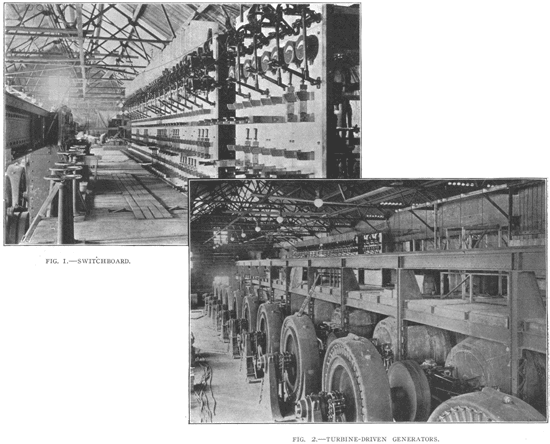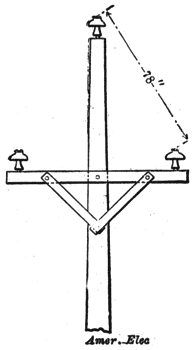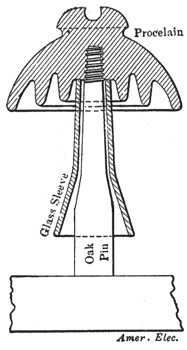[Trade Journal]
Publication: American Electrician
New York, NY, United States
vol. 19, no. 7, p. 323-324, col. 1-3,1-2
THE 50,000-VOLT TRANSMISSION PLANT OF
THE MISSOURI RIVER POWER COMPANY.
BY W. G. M'CONNON.
Although several plants have been proposed for the use of voltages higher than 40,000, the distinction of being the first to place in actual commercial service a large plant employing 50,000 volts transmission belongs to the Missouri River Power Company. This installation was completed and the apparatus placed in operation about the first of March, and it is to be noted that since the starting of the plant there has been no mishap of any kind to the line or apparatus. This, the writer believes, is somewhat exceptional in undertakings of this magnitude and character, since it is generally expected that at the start minor difficulties are liable to be met with which, though possibly not serious, will nevertheless affect the continuous service of the plant.
The present power-house of the Missouri River Power Company is located on the Missouri River about twenty miles from and almost directly east of Helena, Mont., at the mouth of what was formerly known as Black Rock Canyon, and in the town of Canyon Ferry. At the mouth of the canyon a dam has been thrown across the river, about 480 feet in length and designed to give a 30-ft. head of water. The location of the dam at Canyon Ferry enabled the company to take advantage of a low-lying valley just above the entrance of the canyon in which to hold at all times a large volume of water in reserve. At the upper end of the canyon the water spreads out over this valley, forming a lake about seven miles long by two to three miles wide. The canyon by which the water comes to the power house is from 400 to 700 feet wide, and less than one-half mile long. The water in it does not freeze over in winter, and although the lake above freezes over, water flows to the power-house as free from ice in winter as in summer. The amount of water in the river at this point is considered sufficient to develop 10,000 horse-power the year around.
The project for a power plant at Canyon Ferry was first started about ten years ago. About four years ago, the decision to carry out the work at Canyon Ferry took definite shape, and work was started on a plant of 4000 horse-power, which consisted of four 750-kw. 550-volt two-phase Westinghouse generators, driven by Dayton Globe Iron Works water-wheels, and two 90-kw. exciters driven by independent wheels. The current from these alternators was raised by eight oil-cooled transformers from 550 volts to 10,000 volts, and transmitted to Helena and East Helena 20 miles and 14 miles away, respectively, for lighting and power service, being reduced to 2200 volts.
 |
Recently the plant was largely increased and the equipment overhauled. The company has installed six additional 750-kw. Westinghouse generators with the necessary transformers, exciters, etc. These generators are of the same size and voltage as the first four, but are three-phase instead of two-phase and are driven by 45-in. horizontal McCormick wheels furnished by S. Morgan Smith of York, Pa. All generators in the power-house are direct connected to the wheels, flexible couplings being used throughout. With the new generators there was also installed a 225-kw., 150-volt exciter driven by a separate wheel, and a 115-kw., 150-volt exciter driven by an induction motor. To make the plant uniform throughout, the four old generators have been overhauled and changed from two-phase to three-phase. Fig. 2 shows the arrangement of generators, the switchboard gallery being on the right, directly over the water-wheels. Each water-wheel has its own governor; all the new and one of the old wheels having Lombard governors, and the remaining old wheels Replogle governors.
The switchboard gallery extends the whole length of the building, and besides carrying the switchboard carries also twelve 550 to 10,000-volt, oil-cooled transformers for the Helena and East Helena service, as well as a plug board for connecting these circuits as needed under various conditions. The main switchboard and exciter switchboard shown in Fig. 1 are both relatively simple boards in design, but massive and substantial in construction. The main board is 47 ft. 4 in. long and consists of 17 panels of blue Vermont marble, 2 in. thick. The weight of the board complete is about 20 tons, the copper alone being one-half of this weight.
The first five panels at each end are generator panels. The next two panels are feeder panels and are intended for use with the 550 to 10,000-volt transformers. The eighth panel from the end on each side supplies a bank of transformers, 550 to 50,000 volts for lines extending to Butte. The middle panel is a junction panel, on which any set of bus-bars on the two ends of the board can be thrown together, there being three sets of bus-bars on each end of the board. The instruments mounted on the board consist of eight 750-volt, alternating-current voltmeters, one for each set of bus-bars and one at each end for the machines, independently of the busses; ten alternating-current ammeters, sixteen polyphase indicating wattmeters, and six polyphase recording wattmeters. The recording wattmeters are behind the board. The exciter board consists of four panels of blue Vermont marble, similar to the main board, one for each exciter, with two sets of bus-bars. All field rheostats are mounted under the gallery floor and are controlled by hand wheels, the shafts of which come up through pedestals in front of the boards.
 |
| Fig. 3. |
The distance by pole line from Canyon Ferry to the Butte sub-station is 65 miles, the route corresponding nearly with that taken by the Great Northern Railroad between East Helena and Butte. There are two lines of poles about 50 feet apart, each carrying a line of three cables arranged in an equilateral triangle, with a spacing of 78 ins. between the centers, as shown in Fig. 3. Each line consists of three seven-strand copper cables, each cable having a cross-section of slightly over 106,000 c.m. These cables are transposed five times between Canyon Ferry and Butte. The average distance apart of the poles in each line is 110 feet. Fig. 4 shows a cross section of the insulator used on the line, together with the glass sleeve fitting over the pin below the insulator. It has been found after making exhaustive tests, that a thoroughly dry oak pin, of the length used in this installation, boiled in paraffin will readily hold up alone under 50,000 volts. Hence the object of the glass sleeve below the insulator is to keep as great a length as possible of the pin dry under all conditions of weather.
 |
| Fig. 4. |
The transformers at each end of the line consist of six 950-kw. oil-insulated transformers with water-cooling coils in the cases. Those at Butte transform from 50,000 to 2200 volts. The secondary circuits at Butte consist of 600,000 c.m. bare copper cable.
The customers of the Missouri River Power Company at present are the Helena Power & Light Co., Helena & Livingston Smelting & Reduction Co., American Smelting & Refining Co., and the Big Indian Mining Co., at Helena and East Helena; and the Anaconda Copper Co., Butte & Boston Copper Co., Colorado Smelting & Mining Co., Boston & Montana Copper Mining Co., and Washoe Copper Co. at Butte.
